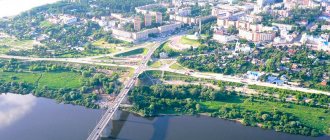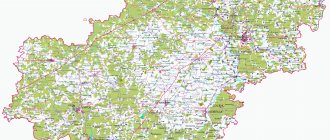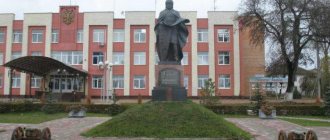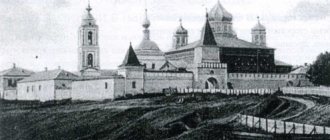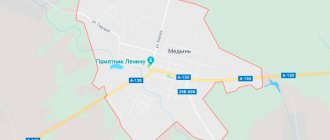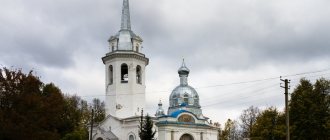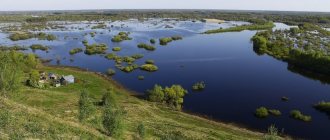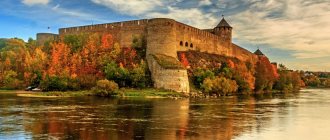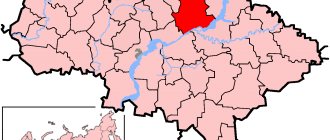Borovsk is the administrative center of the Borovsky district, which in 2000 received the status of a historical city of Russia.
Surrounded by forests, Borovsk is located on the hills on both banks of the Protva River, approximately 20 km from the Balabanovo station of the Kyiv direction of the Moscow Railway and 84 km southwest of Moscow. The city covers an area of about 1044 hectares. It is connected by highways to the cities of Balabanovo, Ermolino, Obninsk and Maloyaroslavets, as well as Medynsky and Zhukovsky districts and the Moscow region.
Brief historical background
Presumably, Borovsk arose in the 13th century. The first mention of the city is contained in the spiritual charter of Grand Duke Ivan Ivanovich II the Red, dated 1358, but the ceramics found at the Borovsky settlement date back to an earlier time, from the 11th to the 13th centuries, which indicates the existence of an ancient Russian settlement here. Archaeological excavations and surveys of modern Borovsk (2003) also show that in the 13th-14th centuries, at a distance of 500-800 meters from each other, there were settlements on the left bank of the Protva River (“Petrova Gora”) and on the right bank (at the ancient settlement and in the area of Kosovo ravine).
Around 1378, Dmitry Donskoy transferred Borovsk, along with several volosts, to Prince Vladimir Andreevich the Brave and the city became one of the centers of the Serpukhov-Borovsk principality, which existed until the 3rd quarter of the 15th century. In 1480, Ivan III, who owned the city, prepared troops near Borovsk for battle with the Horde.
In the 17th century, Borovsk became the scene of the tragedy of the Old Believers. Archpriest Avvakum was exiled here, and his comrades, the noblewoman Morozova and her sister Princess Urusova, were placed in the Borovsky prison (and there they were killed).
Since 1776, Borovsk has been a district town of the Borovsky district of the Kaluga governorate (since 1796 - the Kaluga province). In 1777, the coat of arms of Borovsk was established.
During the Patriotic War of 1812, the city and the Pafnutiev Monastery were burned and devastated by the French. In May 1857, the city was badly damaged by fire - 150 residential buildings, 200 shops and several churches burned down.
From 1880 to 1891, K. E. Tsiolkovsky lived in Borovsk, working here as a teacher. Around the same time, the religious thinker N. F. Fedorov lived and taught here.
Since 1929, the city has been the center of the Borovsky district of the Kaluga district of the Moscow region (since 1944 - the Kaluga region).
Holy waters of Borovsk and surrounding areas
There are underground springs in the city and its environs. Their waters are considered holy. They heal and encourage all believers.
Source at the Church of the Intercession of Our Lady on Vysokoye
- Coordinates on the map: 55.208666, 36.505909.
On the right bank of the Protva River there is a spring revered by believers. It is consecrated in the name of the Intercessions of the Most Holy Theotokos. The holy spring is a well-equipped and well-maintained place. The name of the area where spring waters flow is no coincidence. Vysokoe is a hill from which beautiful views of Protva and its shores covered with lush vegetation open up.
There is a descent to the source, decorated with pieces of marble. There is a Worship Cross nearby. On the territory of the spring there are two separate fonts for believers. Visitors will be delighted by the flowers planted everywhere. After visiting the source, you can relax in the cozy “Tea House”, located here, which uses crystal clear spring water.
Springs of Dmitry Solunsky and Nicholas the Wonderworker
- Address: 55.214463, 36.541027; 55.208552, 36.566088.
Holy springs are located in the village of Ryabushki. Now, along with Roshcha and Yuzhny, these are urban microdistricts of Borovsk. The springs were consecrated in honor of St. Nicholas, Archbishop of Myra in Lycia. The springs come to the surface a few hundred meters from the Church of Demetrius of Thessalonica.
The place where the Holy Springs flow has been ennobled. There is an indoor swimming pool with a plunge pool. An annual procession of the Cross takes place to the springs. On the Feast of Epiphany, the Great Rite of Water Blessing is performed.
Coat of arms
The coat of arms of the urban settlement "City of Borovsk" was approved by decision No. 67 of the City Duma on July 26, 2006 and entered into the State Heraldic Register of the Russian Federation with the assignment of registration number 697.
It is a silver heraldic shield on which there is a red heart with a gold cross, surrounded by a green laurel wreath.
The coat of arms of Borovsk was developed on the basis of the historical coat of arms of the district town of Borovsk, Kaluga province.
The use of a historical coat of arms by a modern city symbolizes the continuity of the history of the city’s development, the preservation of traditions and the memory of the glorious deeds of our ancestors.
Yellow color (gold)
A symbol of wealth, stability, respect, warmth.
White color (silver)
A symbol of purity, perfection, peace and mutual understanding.
Red color
A symbol of courage, strength, life-affirming energy, celebration and beauty.
Green color
Symbol of nature, health, growth.
The historical coat of arms of Borovsk (1777) was reconstructed by the Union of Heraldists of Russia.
Authors of the reconstruction of the coat of arms
Idea
Konstantin Mochenov (Khimki)
Artist
Robert Malanichev (Moscow)
Computer design
Galina Rusanova (Moscow); Sergey Isaev (Moscow)
Rationale for symbolism
Kirill Perekhodenko (Konakovo).
On October 4, 2005, the Bank of Russia issued a commemorative coin with a face value of 10 rubles, from the Ancient Cities of Russia series, on the reverse of which the coat of arms of Borovsk is depicted.
From whom are we saving Borovsk? Why local residents are fighting against city defenders
The demolished houses, according to the historian, were much less interesting than the existing ones, whose fate no one cares
Photo: Evgenia KOROBKOVA
“Save Borovsk! The ancient city is being razed to the ground, stop the vandals,” - last week my page on social networks was flooded with publications from city defenders, members of the Archnadzor and cultural figures. The publications were accompanied by photographs of ruins, so that the conclusion was easily suggested. The authorities decided to present the city with a gift in the symbolic year of the 660th anniversary and undertook to free Borovsk from the merchant mansions of the 18-19th century. We started straight away from the historical center.
Lately, the city of Borovsk has been on my news agenda. And for me personally, it began with the name of the poet Valery Prokoshin. The capital's culture traders, who discovered Prokoshin, experienced incomparable delight when they found a real great poet in the provinces. After Prokoshin’s death, a poetry prize was organized in his name, and after a while, details of his biography began to emerge. For example, an amazing love story. How a young man fell in love with a woman not only 17 years older than him, but also confined to a wheelchair. How she chose his friend as her life partner, how he cried under the windows on the wedding day... Willy-nilly, you’ll want to come and see his muse, the artist Lyudmila Kiseleva. By the way, she still lives in the city...
Activists from different cities gathered in Borovsk to save what was left after the pogroms. Photo: Irina Kobzar
A few months ago, the topic of Borovsk came up again, this time in a conversation with Dina Rubina. The popular fiction writer has released the first part of a new thick novel, the action of which partly takes place in a village near Borovsk. Rubina said that in these parts the memory of Napoleon’s “Golden Convoy” is still alive - a cart with gold looted by the French, which disappeared without a trace.
And now - Borovsk again. And mansions are on the agenda.
And everything that happens around the mansions is terribly surprising.
It would seem that you never know what is being demolished somewhere. But here the hype was unprecedented. The story about the outrages of local authorities was broadcast on federal channels. In a matter of days, a cultural landing force from four cities landed in the city. They sought a meeting with the mayor and trumpeted their disagreement over the demolition. Under the pressure of steel and fire, the unprecedented happened. Local historians turned out to be stronger than the authorities. The mayor gave in.
The demolition of houses has stopped. All decisions regarding historical development were transferred to volunteer local historians. It would seem like a victory. But it was not there. Local residents went on the attack. They threaten to burn down the houses being saved and call on those who have come in large numbers to keep their hands off Borovsk.
The salvation of historical buildings is carried out exclusively by those who have come in large numbers. Photo: Irina Kobzar
Yes, it's important to note. The salvation of historical buildings is carried out exclusively by those who have come in large numbers. “The locals don’t care,” says Anna Aleshnikova, a local historian and activist of the All-Russian Popular Front from Obninsk.
What's going on there?
Journey
Together with the historian Mikhail Korobko we are going to Borovsk. Korobko is sure that this is some kind of manipulation. He does not understand the origins of the unprecedented hype. Objects were demolished, demolished and continue to be demolished, but to make such noise is nonsense.
However, perhaps the fact is that next year Borovsk should have been given the status of a historical settlement. This means that tourists will flock to the city, it can become a brand like Kolomna. To be deprived of your main street on the eve of this event is at least strange...
Getting to the future historical settlement, where shoals of tourists should flock in the future, is not easy. There is no direct transport. By train to Balabanovo, then by minibuses, taxis, dogs... However, while waiting for the minibus, we stock up on the local press.
“Phoenix houses” is the name of a large article in the Borovskiye Izvestia newspaper, the tone of which is radically different from what is written on FB. “Dilapidated houses are being demolished in Borovsk. For some reason, the people stirring up the scandal do not say that the objects will be restored to their former historical form,” reads the subtitle, obviously reflecting the official position of the authorities.
The mansion not far from the Shokin estate is completely covered with siding, but this circumstance does not attract the attention of public figures
Photo: Evgenia KOROBKOVA
From the material it follows: eight dilapidated buildings are subject to demolition, and the people who lived there before were provided with apartments in new buildings under the program for relocation from dilapidated and dilapidated housing.” People are happy because (a quote is given) mice, rats, mold, cold reigned in the old buildings, most of the buildings “consisted entirely of wooden walls and ceilings, which turned into dust before our eyes.” The article notes that objects that have signs of cultural heritage will be restored, and the coda to the material is an effective passage: “it’s one thing to take tourists around the city who, throwing up their hands, admired the dilapidated, but original architecture of bygone times, and quite another - living in these conditions and just passing by dilapidated buildings every day. I wonder how opponents of the demolition of dilapidated buildings would argue if they themselves found themselves the owners of apartments in a dilapidated but architecturally valuable building?
In general, a lot becomes clear.
Types of Borovsk
Photo: Evgenia KOROBKOVA
Oh wonderful old Borovsk
When Dina Rubina said that Napoleon was still remembered in Borovsk, I didn’t really believe her. But in vain. Here people are still alive and not so faithful to the deep antiquity, generously mixed with delirium and insanity. The long two-story barracks is decorated with a poster “DOSAAF, driver training...” and is surrounded by something like a fence made of car tires. “This is a former prison, noblewoman Morozova sat here,” a local resident says in a casual tone. - There, you see, the tree grows, she is buried there. And here, where you stand, lay a tombstone from the grave of noblewoman Morozova. Opposite is a cinema. As children we stood on the stove so that we could look higher...
Now the slab is kept in a small chapel and, according to the aboriginal woman, touching it heals infertility.
There is so much history in this city that it seems that neither local residents nor cultural figures perceive it as valuable. The yellow mansion with a monument to Lenin at the entrance is called “Napoleon’s house” by Borovets residents. The French emperor stayed here two hundred years ago. And there are graves of French soldiers in the city, and the locals also know where Napoleon’s train was buried. Or they guess.
Types of Borovsk
Photo: Evgenia KOROBKOVA
Apparently, the demolition of historical mansions, which agitated the outside public, is perceived here as “what’s wrong with us, at least we can eat it.” Together with Irina Kobzar, head of the cultural and historical department, we examine the scale of the destruction of the city. Honestly, after all the posts on Facebook, you expect to see the city razed to the ground, like after a bombing. But nothing like that. Only the ruins at the end of the main Lenin Street are obvious. To view other destroyed and preserved objects, you have to make a significant detour, and even guides do not find them right away. The ancient mansions here are like mushrooms in the forest. Stone ground floors, wooden top. Conveniences are on the street, but there are huge cellars and glaciers from Catherine’s times. A local resident of a hundred years old is still alive, telling how she fell into this cellar as a girl during the war and how a Czech soldier pulled her out of there. Those who can tell how a whole truck with dresses, clothes and household items of the 19th century were taken out of the house of the deceased sisters are still alive...
“We are lucky that there is only one excavator in the city,” says Irina Kobzar. — We managed to demolish three buildings before the public intervened...
Not far from the Shokin estate, the mansion is completely covered with siding. but this circumstance does not attract the attention of public figures
Photo: Evgenia KOROBKOVA
The Little Blue Excavator and the Vanished Heritage
The city administration began to implement its order dated December 29, 2021, according to which, by the end of 2018, 17 (not 8, as stated in the Borovsky Izvestia publication) residential buildings declared dilapidated and unsafe should be demolished.
“The trouble is that, in addition to the unremarkable buildings on the outskirts, twelve merchant houses from the 19th and early 20th centuries on the central streets were sold. Some of these houses had signs of historical heritage, others were under consideration... But the most offensive thing is that the house on Lenin Street, 22, where activists of the Tom Sawyer Fest, a movement, worked in 2017-2018, was included in the “hit lists.” putting historical houses in order. True, the administration soon announced that this address was on the list by mistake,” says our guide.
The attack on the historical city began on October 13, when, right in front of the sightseers, a blue excavator drove up to the mansion at 42 Lenin Street. Despite the building’s declared emergency condition, the collapse took three days. Then they dealt with house 31 on Volodarsky Street. On October 17, demolition began on Volodarsky Street, 29...
Activists point out unkindly that the demolition was started for a reason. They say that until the city is declared a historical settlement, it is beneficial for the authorities to demolish as much as possible in order to free up the territory for the construction of an apartment building. City defenders do not believe the mayor’s assurances that historical houses will be restored.
- Yeah, they will restore it. Instead of a two-story house, we have already built a three-story one. On the site of another historical house, there is now, for example, a market where they sell shawarma,” says Kobzar.
The head of Borovsk, Mikhail Klimov, published an explanation on the issue on his website. It follows from it that the demolition was not caused by considerations of quickly selling the land, but “due to the onset of cold weather and in order to exclude the possibility of antisocial elements staying in the resettled houses.”
It was precisely in order to exclude the possibility of “asocial elements staying in resettled houses”, but at the same time not subjecting the houses to demolition, a landing of volunteers from four cities organized a cleanup day on October 20.
When eighty people from Moscow, Kaluga, Obninsk and Maloyaroslavets gathered in Borovsk for an unbearable subbotnik, conserving the remaining houses, there were no Borovsk residents among them.
Local residents gathered solely to watch the newcomers work. They muttered the phrase “come in large numbers” through clenched teeth. They threatened: “We’ll still set fire to your houses.”
“The locals don’t care about their historical buildings.” Moreover, they really don’t want the city to be given the status of a historical settlement,” says Aleshnikova.
Who are Borovchane
Maybe because Borovsk is the center of the Old Believers, maybe for some other reason, but the Borovsk people are a specific people, strict, distrustful, with their own views on history. Ivan the Terrible, for example, is respected here. Because Ivan the Terrible is one of our own, for his appearance many years ago the residents of Borovsk prayed for news of the Terrible’s father, Vasily the Third. They don’t like strangers here and are still proud that they did not recognize False Dmitry. Just as they do not recognize non-locals who have undertaken to organize the life of their hometown. So the Kobzari couple have lived in the city for twenty years, and, it would seem, have done a lot for the city (for example, they established a cultural-historical museum on their own), but they are still perceived as “strangers”, “promoting publicity”, “crushing Borovsk under their control”.
“We have already found investors who were ready to buy the houses that had been evacuated. They could be used as a hotel, a cafe, or an art gallery. But the buildings were demolished,” says Vladimir Kobzar, director of the cultural and historical center.
But the locals don’t want a hotel, a cafe or an art gallery. “Borovsk for Borovsk”, “Moscow, hands off Borovsk,” read the posters they unfurled.
Why are locals afraid of changes in the city's status?
When walking around the city, it’s not even the destroyed mansions that are impressive, but the still existing ones. The very first house on the main Lenin Square was abandoned, exposed to all the winds and turned into a homeless shelter... An old mattress with red spots of admiral butterflies stuck to the window on the main street was displayed in the window, double-glazed windows inserted into the window openings of ancient houses and houses, historical buildings lined with siding, mansions with an ugly second floor, hanging like an absurd cap, but which increased the meters for some of the residents...
Locals are afraid that when the city is given the status of a historical settlement, they will be forced to put the facades in order, take out the double-glazed windows installed at the last penny, and will be deprived of the opportunity to get normal housing with a bathroom and a warm closet. In some ways, Borovskiye Izvestia is right: historical buildings are good for tourists to look at, but living in them is a dubious pleasure.
“We need to convey to people the benefits and prospects of giving the city the status of a historical settlement,” says the head of Arkhnadzor, Konstantin Mikhailov. — Huge budget funds are allocated for historical settlements, and judging by the reaction, local residents do not really understand this.
He's right, we need to report it. But who will do it?
On October 23, the city administration held a meeting with city defenders. During the six-hour conversation, the defenders offered options on how to deal with dilapidated housing without demolishing it, and what Borovsk should do next. According to the organizer of the Arkhnadzor movement, Ruslan Rakhmatullin, it was possible to realize a Moscow dream - to initiate the creation of a council for the preservation of the cultural heritage of the city of Borovsk. This is a working group, without which it will be impossible to demolish anything. Demolition of historic buildings was suspended for six months.
“We have time to submit applications to the addresses of dilapidated houses and again recognize them as objects of cultural heritage,” notes Aleshnikova. — And then, whether the Borovsk residents want it or not, we will work to create a tourist Mecca in Borovsk, for example, like Kargopol...
Results of the event
Korobko is not satisfied with what he sees. He says that the latest targeted demolitions are not the biggest problem of Borovsk as a historical city.
“Honestly, I am more impressed not by the demolished houses, but by the condition of the existing buildings,” says the historian. — A lot of pre-revolutionary buildings are covered with siding, rebuilt or replaced with new buildings by private owners. All parties to the conflict pretend not to notice this, obviously approaching the state with one measure and private citizens with another. The disregard for existing pearls is striking. The fantastically beautiful wooden “Shokin estate”, which has been waiting for restoration for many years, is falling to one side and, apparently, is living its last days. There are other unique objects that are more interesting than demolished houses.
City estate of merchant F.I. Shokin with the richest carved decoration of the main facade. - the most beautiful merchant mansion of Borovsk
Photo: Evgenia KOROBKOVA
In the vast expanses of Borovsk, Korobko found the remains of a Russian-style estate. Having walked around the city, the historian concluded that there are no such buildings here anymore...
Korobko is perplexed why the demolition of three petty-bourgeois houses is considered the disappearance of the city, but the death of real masterpieces of architecture is not. The paintings on the walls of historical buildings received particular bewilderment. Which... is too much.
At the same time, its fate is not even discussed publicly; the latest fuss is associated with the hype around not very significant ordinary buildings
Photo: Evgenia KOROBKOVA
A few words about painting
In the first house, upon entering the main square, we are greeted by a painted noblewoman Morozova, looking through a three-leaf window painted on the facade. Most of the houses in the center are painted by local Banksy, artist Vladimir Ovchinnikov. The assortment includes Tsiolkovsky, the artists of Borovsk, the poet Prokoshin (locals say he doesn’t look like him), victims of the repressions of 1937... (True, the authorities paint over the portraits of the victims of the repressions, but eighty-year-old Banksy paints them again). Sometimes the pictures are accompanied by poems of dubious quality that are not written by Prokoshin. Restrained amazement at whether it is good to paint historical houses is met with an angry rebuke from the locals: “Ovchinnikov is ours. If you don't like it, go to your place. It’s all of your houses painted with the word “***”.”
Most of the houses in the center are painted by local Banksy - artist Vladimir Ovchinnikov
Photo: Evgenia KOROBKOVA
In a word, Borovsk is beautiful. The density of living history, living memory of it, a different flow of time. This is a paradise for those who do not like folk villages like Suzdal, believing that the real thing has been replaced with an ersatz one. But its problem is not at all in the three demolished houses, but in the fact that the city, like a swan, a cancer and a pike, is being dragged in different directions by those who know better than others how it should be done. Firstly, these are the residents themselves. Having suffered and living in frightening conditions, they know that they must live in comfort. And if so, then you can cover historical buildings with siding and make monstrous toppings and want, passionately desire, to move out of these historical monsters.
A few words about painting
Photo: Evgenia KOROBKOVA
There are authorities who know how to do it. It is necessary, before it is too late, to get rid of the huts, where it is possible to build new housing, or replace something with an analogue.
There is a local creative intelligentsia who also knows how to do it. You have to spend five hours on exhausting excursions, reading poems of your own composition near each object. It is necessary to paint the facades of all historical buildings. Why not, after all, the city is ours and we, as if in our own entrance, can make it whatever we want.
There is a problem: with the status of a historical settlement being given, the city will soon become “not ours”.
Therefore, collectors and art connoisseurs “from the outside” appear. They also know what needs to be done to make the city attractive to tourists: we need cafes, shops, hotels for tourists. So that it would be like in Kargopol or like in Kolomna and generate income.
On the threshold of the moment when the city will be given the status of a historical settlement, none of these problems can be considered less important than the demolition of three mansions. But there is one more “must”: “we must learn to negotiate among ourselves.” Yes, local residents do not want to live in huts. And future tourists are unlikely to want to see Banksy’s works everywhere and listen to tours with poetry.
Culture
District House of Culture
Borovsk, st. Lenina, 17 Phone: 8 (48438) 4-35-10, 4-35-19 Fax: 8 (48438) 4-16-65
MUK "Museum and Exhibition Center"
Borovsk, st. Lenina, 27 Phone: 8 (48438) 4-27-04
Cultural and methodological association
Borovsk, st. Lenina, 17 Phone: 8 (48438) 4-35-19
Branch of the State Budgetary Educational Institution KO "Borovsk Local Lore Museum"
Borovsk, pl. Lenina, 7 Phone: 8 (48438) 4-32-36, 4-32-78
Museum-apartment of K.E. Tsiolkovsky - branch of the State Museum of the History of Cosmonautics in Kaluga
Borovsk, st. Tsiolkovskogo, 49 Phone: 8 (48438) 4-39-99
Attractions
- Pafnutyevo-Borovsky Monastery, an ensemble of architectural monuments of pre-Petrine times (XVI-XVII centuries).
- Borovsky Museum of History and Local Lore (branch of the Kaluga Regional Museum of Local Lore): pl. Lenina, 7.
- Museum-apartment of K. E. Tsiolkovsky: st. Tsiolkovsky, 49
- Monument to Tsiolkovsky
- Church of Boris and Gleb (the temple was built in 1704, the bell tower - in 1819): st. Communist, 102
- Chapel-monument at the supposed place of imprisonment and death of Boyarina Morozova and Princess Urusova
- A large number of both existing and awaiting restoration churches on the territory of Borovsk itself and in its environs
- Monument to Admiral Senyavin, a native of Borovsky district
- Within the city of Borovsk there is the All-Russian Research Institute of Physiology, Biochemistry and Nutrition of Farm Animals, famous for its developments in the field of feeding farm animals, biotechnology of microorganisms, cellular and genetic engineering
Education
Municipal educational institution "Secondary school No. 1 of Borovsk"
Borovsk, st. Lenina, 26 Phone: 8 (48438) 4-32-26, 4-39-15, 6-63-61
Municipal educational institution "Secondary school No. 2 of Borovsk"
Borovsk, st. Lenina, 47 Phone: 8 (48438) 4-39-58
Municipal educational institution "Evening (shift) secondary school"
Borovsk, st. Kommunisticheskaya, 3 Phone: 8 (48438) 4-39-49
Municipal educational institution "Secondary general education noospheric school"
Borovsk, st. Bolshaya, 38 Phone: 8 (48438) 4-35-32
Municipal educational institution "Secondary school No. 4, Borovsk-1"
Borovsk-1 Phone: 8 (48438) 4-41-78
MDOU "Kindergarten No. 3 "Ryabinka"
Borovsk, st. Kommunisticheskaya, 69 Phone: 8 (48438) 4-41-24, 6-63-51
MDOU "Kindergarten No. 4 "Brigantine"
Borovsk, st. Mira, 62a Phone: 8 (48438) 4-18-90, 4-42-68
MDOU "Kindergarten No. 5 "Yablonka"
Borovsk, st. Kommunisticheskaya, 15a Phone: 8 (48438) 4-42-27
MDOU "Kindergarten No. 8 "Caramel"
Borovsk, st. P. Shuvalova, 18 Phone: 8 (48438) 6-63-60
MDOU "Kindergarten No. 16 "Topolek"
Borovsk, Institute village Telephone: 8 (48438) 6-62-67, 6-61-80
Social Services
Department of Social Protection of the Population
Borovsk, st. Sovetskaya, 5 Phone: 8 (48438) 4-32-43 (manager)
Center for Social Services for Elderly and Disabled Citizens
Borovsk, st. Lenina, 22 Phone: 8 (48438) 4-16-01, 4-27-61, 4-25-61
Center for social assistance to families and children "Harmony"
Borovsk, st. Sovetskaya, 6 Phone: 8 (48438) 4-42-15, 6-62-69
State Institution "Employment Center of the Borovsky District"
Borovsk, st. Lenina, 74a Phone: 8 (48438) 4-30-49, 4-26-81, 4-30-59
